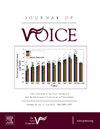Superior Laryngeal Nerve Block in Transcutaneous Vocal Fold Injection: A Pilot Study
IF 2.4
4区 医学
Q1 AUDIOLOGY & SPEECH-LANGUAGE PATHOLOGY
引用次数: 0
Abstract
Objectives
Topical lidocaine remains the mainstay for anesthesia in transcutaneous vocal fold injection (VFI). While using topical lidocaine, laryngologists sometimes encounter uncontrolled reflexes or poor compliance. Superior laryngeal nerve block (SLNB) provides deep and rapid anesthesia on the larynx above the vocal folds and abolishes the glottic closure reflex. Herein, we present a pilot study to evaluate the feasibility and safety of SLNB for transcutaneous VFI and explored its usefulness.
Methods
Fifty-nine patients were prospectively anesthetized with SLNB during transcutaneous VFI for unilateral vocal fold paralysis. In the SLNB group, 0.5 to 1 mL of 2% lidocaine was infiltrated on bilateral SLNs through the thyrohyoid membrane. As the control group, we included previous 47 patients who underwent VFI with topical lidocaine. In the control group, 10% lidocaine spray was applied to the laryngopharyngeal mucosa. Demographic data, laryngeal exposure, patient compliance, procedural interruption, and complications were investigated. Patient compliance was evaluated based on the frequency of cough and swallowing during VFI procedures.
Results
SLNB enabled endoscopic contact on the epiglottis and pharyngeal wall without gag reflex and provided good exposure of the procedure field on the vocal folds. In the SLNB group, the laryngeal exposure is significantly better than in the control (P = 0.005). The frequency of cough and swallowing was significantly lower in the SLNB group than in the control (P < 0.001). The number of procedural interruptions was lower in the SLNB group than in the control (P < 0.001). There was no acute or delayed complication related to SLNB such as bleeding, hematoma, delayed sensory/swallowing problems, or unscheduled hospital visits.
Conclusions
SLNB might be safe and effective for anesthesia in transcutaneous VFI. SLNB could be a good anesthetic option for patients with poor compliance despite the sufficient application of topical lidocaine.
Level of Evidence
4
经皮声带注射中的喉上神经阻滞:一项初步研究
目的在经皮声带注射(VFI)中,利多卡因仍是首选的麻醉方式。当使用局部利多卡因时,喉科医生有时会遇到不受控制的反射或依从性差。喉上神经阻滞(SLNB)为声带以上的喉部提供深度和快速麻醉,并消除声门关闭反射。在此,我们提出了一项初步研究,以评估SLNB用于经皮VFI的可行性和安全性,并探讨其实用性。方法对59例单侧声带麻痹患者进行经皮VFI麻醉。在SLNB组,0.5 ~ 1ml 2%利多卡因通过甲状腺舌骨膜浸润于双侧sln。作为对照组,我们纳入了47例外用利多卡因进行VFI治疗的患者。对照组采用10%利多卡因喷雾剂喷搽喉部黏膜。调查了人口统计数据、喉部暴露、患者依从性、手术中断和并发症。患者依从性根据VFI过程中咳嗽和吞咽的频率进行评估。结果slnb使内镜接触会厌和咽壁无呕吐反射,并提供了良好的声带手术野暴露。SLNB组喉部暴露明显优于对照组(P = 0.005)。SLNB组咳嗽和吞咽次数明显低于对照组(P < 0.001)。SLNB组的程序性中断次数低于对照组(P < 0.001)。没有与SLNB相关的急性或延迟并发症,如出血、血肿、延迟的感觉/吞咽问题或计划外的医院就诊。结论sslnb是一种安全有效的经皮VFI麻醉方法。尽管局部应用了足够的利多卡因,但对于依从性差的患者,SLNB可能是一个很好的麻醉选择。证据水平
本文章由计算机程序翻译,如有差异,请以英文原文为准。
求助全文
约1分钟内获得全文
求助全文
来源期刊

Journal of Voice
医学-耳鼻喉科学
CiteScore
4.00
自引率
13.60%
发文量
395
审稿时长
59 days
期刊介绍:
The Journal of Voice is widely regarded as the world''s premiere journal for voice medicine and research. This peer-reviewed publication is listed in Index Medicus and is indexed by the Institute for Scientific Information. The journal contains articles written by experts throughout the world on all topics in voice sciences, voice medicine and surgery, and speech-language pathologists'' management of voice-related problems. The journal includes clinical articles, clinical research, and laboratory research. Members of the Foundation receive the journal as a benefit of membership.
 求助内容:
求助内容: 应助结果提醒方式:
应助结果提醒方式:


